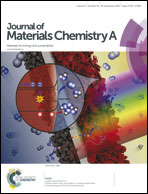Polyelectrolyte interlayers with a broad processing window for high efficiency inverted organic solar cells towards mass production†
Abstract
Neutral polyelectrolyte interfacial layers in organic solar cells are well-known for their ability to tailor the work function of electrodes, improve charge carrier extraction and maximize open circuit voltage. However, they also suffer from low charge carrier conductivity, and therefore the interlayer must be kept thin, which in turn requires very precise deposition. This prerequisite significantly reduces the robustness of the fabrication process and makes such structures difficult to up-scale for roll-to-roll mass production. Herein, we find that by washing the polyelectrolyte layer with N,N-dimethylformamide (DMF) after deposition, solar cell efficiency jumps to near optimum levels, no matter what the original thickness of the polyelectrolyte layer. Subsequent characterization of the DMF-washed ZnO/PEI interlayer reveals a changed surface structure, passivated surface trap states, and thus improved transport properties and lower recombination losses. We demonstrate the general applicability of the method to other state-of-the-art material systems, namely P3HT:ICBA, PTB7:PC71BM and PTB7-Th:PC71BM. We find that the more efficient the material system, the larger the improvement in efficiency after DMF washing. Thus, this method represents a general way to relax the fabrication criteria for high efficiency organic solar cells. We anticipate that this method could be of use in other classes of devices such as OTFTs and OLEDs.



 Please wait while we load your content...
Please wait while we load your content...